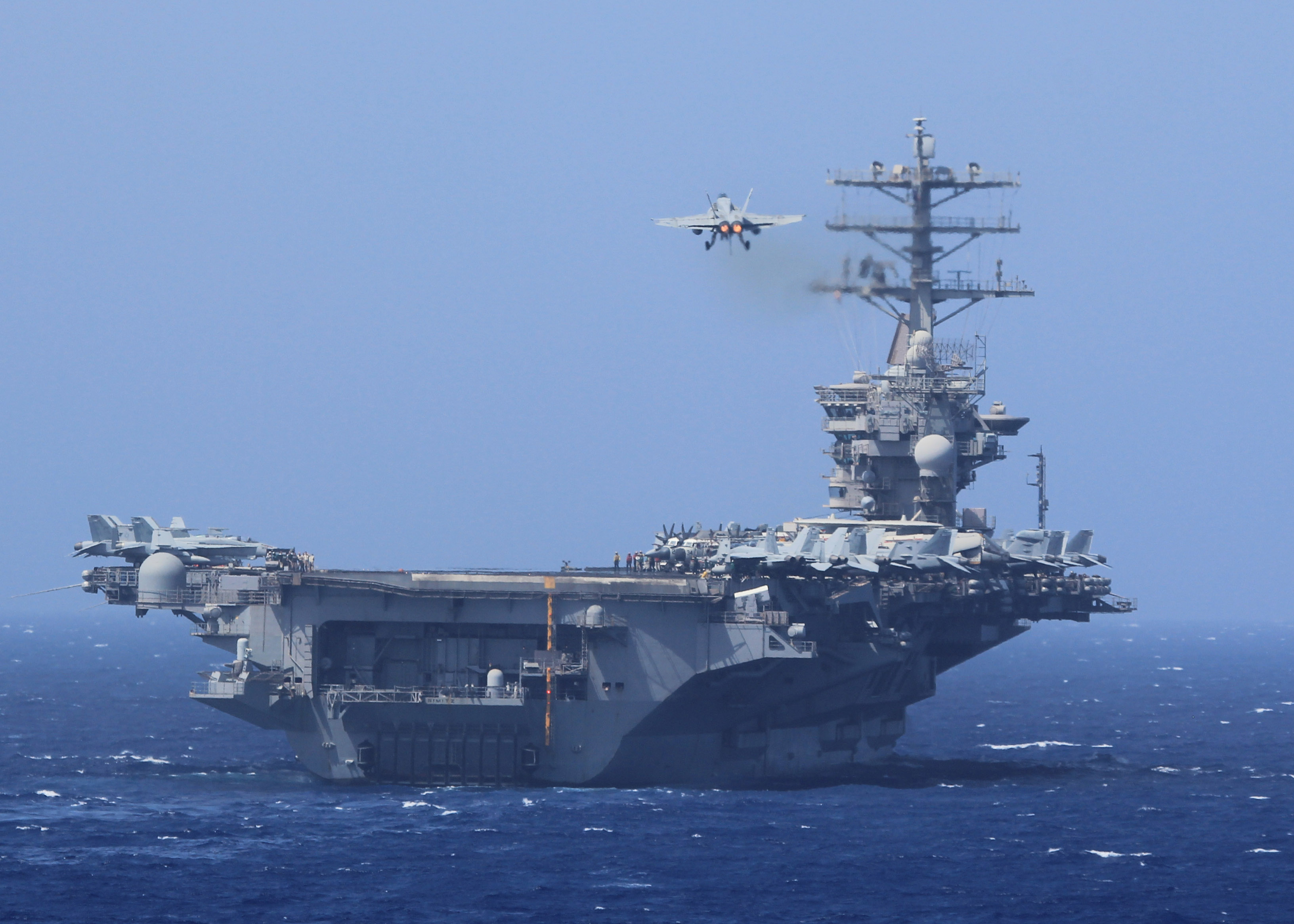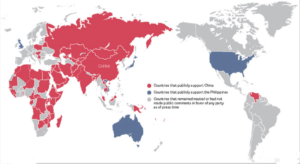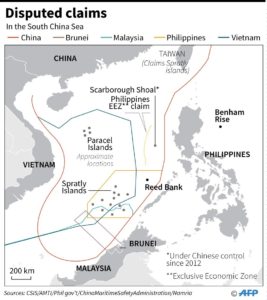The U.S. has held consecutive military exercises in the South China Sea and Pacific since June. The People's Liberation Army of China (PLA) responded with military exercises by demonstrating its presence in the South Sea of China against the US's mobilization in the region. Finally, the Chinese government considered it a provocation that the USS John S. McCain guided missile destroyer was around the Paracel Islands.[1] Why is the South China Sea facing trouble between China and the USA?

Rising tensions between China and the United States
In June, the United States sent 3 aircraft carriers, the USS Theodore Roosevelt, the USS Nimitz and the USS Ronald Reagan, to the Pacific. The aircraft carriers USS Nimitz and USS Ronald Reagan in the South China Sea held an exercise on July 4-6 and withdrew from the region. However a second exercise was held on July 17, attended by the ships USS Nimitz and USS Ronald Reagan, immediately after Mike Pompeo said that ‘We will not allow the South China Sea to be considered a Chinese maritime empire.’ "The dual aircraft carrier operations demonstrate our commitment to regional allies, our ability to quickly fight mass power in the Indo-Pacific, and our readiness to confront anyone who challenges international norms that support regional stability," USS Nimitz's admiral Wickoff said in a statement.[2] The fact that the United States has conducted two military exercises in the South China Sea in a month has raised tensions in the region. In addition, the Pentagon has increased the frequency of Freedom of Navigation Operations (FONOPs) in the South China Sea. In the first seven months of 2020, the US Navy conducted seven FONOPs in the Paracels and Spratlys, compared with eight in 2019, five in 2018 and four in 2017. The US Navy has also conducted a series of high-profile exercises in the South China Sea, including dual aircraft carrier operations for the first time since 2014,-and increased submarine deployments and maritime air patrols.[3] It is certain that the main purpose of these military exercises is operations aimed at balancing China's presence in the South China Sea. After successive US exercises in the region, the PLA conducted military exercises off the South China Sea from August 24 to August 29.
China was aware that the threats against it would increase in the South China Sea, so it prepared its navy for these threats. The fact that the United States has 288 ships and submarines, and China has 400 ships and submarines reveals this fact. That's why China is not afraid of US threats. The fact that China stated that we will not be the first to shoot the bullet in the South China Sea in response to the threats of the USA[4] shows that they act to defend their rights rather than aggression in the region.

Publicised US Navy FONOPS in the South China Sea during the Trump administration
Details of 24 freedom of navigation operations in the region from 2017-2020
| Date | US vessels involved | Location |
| May 24, 2017 | USS Dewey | Mischief Reef, Spratlys |
| July 9, 2017 | USS Stethem | Triton Island, Paracels |
| August 9, 2017 | USS McCain | Mischief Reef, Spratlys |
| October 11, 2017 | USS Chafee | Paracels |
| January 17, 2018 | USS Hopper | Scarborough Shoal |
| March 23, 2018 | USS Mustin | Mischief Reef, Spratlys |
| May 27, 2018 | USS Higgins and USS Antietam | Tree, Lincoln, Triton and Woody Islands, Paracels |
| September 30, 2018 | USS Decatur | Gaven Reef and Johnson Reef, Spratlys |
| November 26, 2018 | USS Chancellorsville | Paracels |
| January 7, 2019 | USS McCampbell | Paracels |
| February 10, 2019 | USS Spruance and USS Preble | Mischief Reef and Second Thomas Shoal, Spratlys |
| May 6, 2019 | USS Preble and USS Chung-Hoon | Gaven Reef and Johnson Reef, Spratlys |
| May 19, 2019 | USS Preble | Scarborough Shoal |
| August 25, 2019 | USS Wayne E. Meyer | Fiery Cross Reef and Mischief Reef |
| September 13, 2019 | USS Wayne E. Meyer | Paracels |
| November 20, 2019 | USS Gabrielle Giffords | Mischief Reef, Spratlys |
| November 21, 2019 | USS Wayne E. Meyer | Paracels |
| January 25, 2020 | USS Montgomery | Johnson Reef and Fiery Cross Reef, Spratlys |
| March 10, 2020 | USS McCampbell | Paracels |
| April 28, 2020 | USS Barry | Paracels |
| April 29, 2020 | USS Bunker Hill | Gaven Reef, Spratlys |
| May 28, 2020 | USS Mustin | Paracels |
| July 14, 2020 | USS Ralph Johnson | Cuarteron Reef and Fiery Cross Reef, Spratlys |
| August 27, 2020 | USS Mustin | Paracels |
Importance of the South China Sea
The South China Sea is a busy international waterway that trade takes places 3.37 trillion Dollars and 40 percent of the world liquefied natural gas trade passes through this sea. It is also known that there are 11 billion barrels of oil and 190 trillion cubic feet of natural gas reserves in the South China Sea.[5] The fact that China's exit to the Strait of Malacca, which shortens the trade route, is on this sea shows the strategic importance of the sea. In short, the South China Sea is a strategic sea that global trade passes through and has a wealth of natural resources. But there are different claims of dominance over the Chinese South Sea between China, the Philippines, Vietnam, Brunei, Taiwan and Malaysia.
Although the United States does not have any territory in the region, it is based on the ASEAN alliance relationship, which was established in 1967 to prevent the spread of communism as a justification for continuous intervention in the region. The USA has been trying to dominate the South China Sea, claiming that China is usurping the rights of other countries. The USA is trying to harm Chinese trade by creating threats in this sea, where China mainly carries out its commercial activities. Therefore, no solution can be found for the domination of the seas in the region. Because, instead of international law, the issue has turned into a political problem in the South China Sea.

China's Claim of Historical Sovereignty in the South China Sea
China claims fishing activity and vessels were present in the area for 2,000 years before the 1982 United Nations Convention on the law of the Sea (UNCLOS). According to the claims of Chinese researchers, they state that the presence of China in the South China sea covers a period of 2000 years that goes back to the Qin Dynasty (221-206 BC) and Han Dynasty (206 BC-AD 220). They also emphasize that during the period when the Qin Dynasty (1644-1911) was active in the South China Sea, Vietnam, Philippines and Malaysia had almost no knowledge about South China Sea.[6] China's claim to sovereignty in the South China Sea is based on fishing and maritime patrols beginning from the 15th century. They point out that China had historical control over the region before Western powers came to the region. However, they state that with the arrival of western powers in the region, the French later caused the Japanese to lose Chinese dominance in the region during the World War II. However, with the establishment of the People's Republic of China, the region again took over. China, based on bitter experience of the past, understood that being vulnerable in the Seas is open to foreign invasion. Kuomintang administration sailed into the South China Sea with 4 warships, Zhongjian, Zhongye, Taiping and Yongxing. On December 12, 1946, the ship named Taiping arrived at the strategically important island of Taiping (太平 島) and took it under its sovereignty.[7] China defined the region in the South China Sea, which includes the islands of Taiwan, Spratly, and Paracel, as 9 dashe line (jiuduanxian 九段线). According to the Chinese maps drawn in 1914 and 1947, this region was stated to belong to the Chinese state. Official maps showing that the 9 dash lines of the South China Sea were under Chinese domination continued to be drawn after 1949.[8] It gained importance again with the discovery of oil and other mineral resources in the South China Sea in 1970. The race over the disputed islands has begun. In 1988, China 7, Vietnam 29, Philippine 9, Malaysia 5, Taiwan 1 captured the island in the southern Johnson Cliffs of the Spratly Islands. The Spratly Islands are a disputed area of the South China Sea. China, Vietnam, the Philippines, Malaysia, Taiwan and Brunei have different claims of sovereignty in the Spratly Islands.
Secondly, the Paracel Islands (西沙群岛; Xīshā Qúndǎo) are disputed territory between Vietnam and China. Paracel is a group of islands located 220 miles (350 km) from the Chinese island of Hainan and 250 miles (400 km) from Vietnam. In 1932, the French occupied the islands, and then the Japanese occupied the islands until 1939-45. In 1947, China dominated the island of Woody, the main island of the Amphitrite group (Part of Paracel Islands). Vietnam claiming that the islands belong to them. But China has de facto sovereignty over all of the Paracel Islands since 1974. Mark Hoskin, a researcher at the Center for International Studies and Diplomacy at the University of London, states that according to independent records, there were Chinese fishermen and vessels on the Paracel Islands in the 1823s. He also states that the North Vietnamese prime minister's statement in a letter he wrote to the Chinese administration in 1958 that Hanoi recognized Chinese sovereignty meant that he recognized sovereignty in the South China Sea.[9]
The South China Sea is 3 million 650 thousand square kilometers in total, and China claims sovereignty over 2 million 100 thousand square kilometers. About 70 countries support China's claim to dominance in the South China Sea. [10]

ASEAN Between China and US
At the 36th ASEAN summit held in Hanoi, Vietnam on June 26, 2020, leaders emphasized that the right to sovereignty in the South China Sea should be resolved on the basis of the 1982 UNCLOS treaty.[11] The relations between ASEAN countries and China are developing on an economic basis. January-August, defying the economic shock of the pandemic, China's trade with ASEAN countries increased 7 percent to 2.93 trillion Yuan (US $ 428 billion).[12] Thus, for the first time, ASEAN has become one of China's largest trading partners. The development of China's economic relations with ASEAN countries may also provide efforts for a solution to the South China Sea. Defense Minister Wei Fenghe's visited to four ASEAN countries (Malaysia, Indonesia, Brunei and Philippines) and Foreign Minister Wang Yi's will visit to four countries in October (Malaysia, Laos, Cambodia, Thailand) can be evaluated with the recently developed relations. As Foreign Minister spokeswoman Hua Chunying stated at the press conference, China's Asean countries are key partners in the Belt and Road Initiative. With Wang Yi's trip, China demonstrates its sincere desire and solution to develop cooperation with ASEAN countries and maintain peace and stability.
At the same time, US Secretary of State Mike Pompeo stated during an online meeting with the foreign ministers of ASEAN countries on September 10, 2020 that China was acting aggressively in the South China Sea, ASEAN have to act against China and the United States would support them.[13] This situation forces ASEAN countries to choose between China and the USA. When ASEAN considered as an organization established by the USA to prevent the spread of communism in the region, there has an effort to use it against the spread of Chinese influence. However, ASEAN is no longer an organization under the control of the former US, for example, it has a communist inside such as Vietnam and Laos, and US relations like the Philippines have turned into deteriorated a organization. ASEAN countries have turned into a situation where the competition between China and the USA and both countries are trying to win. [14]
The South China Sea is a strategic sea and a trade route for China to the world. China sees the South China Sea as a historical part and a region to be defended for its commercial interests. In addition, considering China's historical claim, its de facto sovereignty in Paracel and Spratly Islands, it has an important right in the South China Sea. Also 70 countries have support China's rights in South China Sea that situation favor of China.
Considering the increasing US military exercises in the South China Sea, it seems likely that the tension between the US and China will increase even more. The fact that the PLA also responded with exercises and developed its navy confirms this determination. The US is creating problems in the South China Sea, which is a strategic point in Chinese trade. At the same time, in the US-China struggle in the South China Sea, while the US increases the tensions in the region, China appears in a defensive position against the US. In addition to showing China's military presence, it is seeking a solution in the South China Sea by increasing commercial and political relations with ASEAN. However, it seems likely that ASEAN will be forced to choose between the US and China in the future. The struggle between the US and China in the South China Sea causes the discussion of choosing a political side instead of international law in solving the problem.
[1] https://www.scmp.com/news/china/diplomacy/article/3104971/china-us-relations-pla-slams-provocative-action-us-warship
[2] https://thediplomat.com/2020/06/u-s-navy-dual-carrier-operations-send-message-to-china-allies/
[3] https://www.scmp.com/week-asia/opinion/article/3100563/us-china-tensions-rise-what-outlook-south-china-sea-dispute-2020
[4] https://www.scmp.com/news/china/diplomacy/article/3096978/south-china-sea-chinese-military-told-not-fire-first-shot
[5] https://amti.csis.org/south-china-sea-energy-exploration-and-development/
[6] https://usa.chinadaily.com.cn/opinion/2011-07/22/content_12957473.htm (Accessed 14 Septemper 2020)
[7] Suisheng Zhao (2018) China and the South China Sea Arbitration: Geopolitics Versus International Law, Journal of Contemporary China, 27:109, p.3
[8] Zhao Hong (2013) The South China Sea Dispute and China ASEAN Relations, Asian Affairs, 44:1, 27-43, p.28.29
[9] https://edition.cnn.com/2019/08/29/asia/vietnam-china-paracel-islands-intl-hnk/index.html
[10] https://thediplomat.com/2016/07/who-supports-china-in-the-south-china-sea-and-why/
[11] https://www.theguardian.com/world/2020/jun/27/asean-leaders-cite-1982-un-treaty-in-south-china-sea-dispute
[12] http://www.xinhuanet.com/english/2020-09/12/c_139363479.htm (Accessed 15 September)
[13] https://www.japantimes.co.jp/news/2020/09/10/asia-pacific/politics-diplomacy-asia-pacific/pompeo-asean-china-walk-over-us/ (Accessed 15 September 2020)
[14] https://www.scmp.com/news/china/diplomacy/article/3102259/us-china-rivalry-south-china-sea-has-philippines-its-core Also; https://www.scmp.com/comment/opinion/article/3101449/can-asean-dance-its-way-out-having-take-sides-us-china-conflict
 Copyright secured by Digiprove © 2020 Quixote Globe
Copyright secured by Digiprove © 2020 Quixote Globe